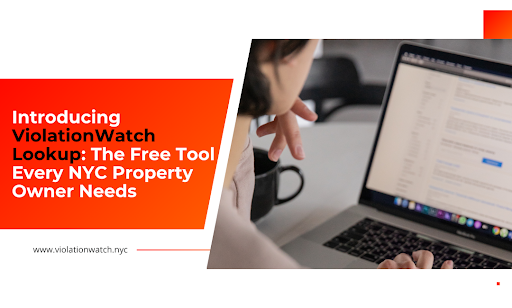Pulling violation records should be quick. Yet, many spend hours hopping between DOB, HPD, 311, FDNY, and DEP sites, trying to piece the picture together. One missed update can trigger fees, delays, or hearings you didn’t see coming. The issue isn’t effort. The issue is fragmentation.
ViolationWatch Lookup brings the data together in one place. No log-in. No cost. Type an address and pull the full violation history in seconds. It cuts the guesswork out and gives you clarity before problems grow.
Here’s what this piece will cover:
- What ViolationWatch Lookup is and why it exists.
- How it brings DOB, HPD, 311, FDNY, and DEP records into one clean view.
- Why centralized violation data helps you act sooner and avoid avoidable fees.
- How Lookup connects with the full ViolationWatch platform for ongoing tracking and resolution support.
If you’ve ever felt like you’re chasing information instead of controlling it, you’ll see how this tool changes that dynamic fast.
Why ViolationWatch Lookup Exists

Information spread across separate violations in NYC department records slows down decision-making. Each agency controls a different layer of the compliance picture, and pulling those layers together demands time and constant attention. Missed updates often lead to costly penalties or delays that disrupt work already in motion.
ViolationWatch Lookup brings everything into a single, clean view. You can check open DOB violations, review ECB violations, note recent sidewalk violations, and scan for any FDNY violations tied to life-safety requirements. The tool also reflects issues connected to housing preservation standards, fire department violations, and complaint patterns that many buildings encounter across New York City.
The Lookup tool works as the first step in a broader operating system for compliance. Once you see the full picture, the ViolationWatch platform can monitor open violations actively, send instant alerts, and help organize supporting documentation for filings, hearings, or administrative trials. This structure prevents situations where criminal summons notices or unresolved issues surprise many property owners after deadlines pass.
Key points to keep in mind:
- No fees to run a search
- No account setup required to begin
- Direct access to DOB, HPD, 311, FDNY, and DEP data
- A single view of the property’s full compliance status
Lookup serves as the front entry. It provides a clear starting point before task planning, contractor coordination, or repair scheduling moves forward.
How ViolationWatch Lookup Centralizes NYC Agency Records

City violation data sits across separate systems. Each agency maintains its own record format, search filters, and update schedules. Pulling address information from one source rarely reflects the complete picture. ViolationWatch Lookup resolves this by collecting, standardizing, and presenting data from key enforcement bodies in one structured view.
The system works through a layered process:
1. Source-Level Data Collection
ViolationWatch Lookup connects to official NYC record sources. Each query fetches live data directly from:
| Agency | Data Pulled | Core Value to the User |
| DOB | Open/closed building violations, stop work orders, complaint histories | Identifies compliance exposure tied to construction or unsafe conditions |
| HPD | Housing maintenance violations, heat/hot water issues, mold complaints | Alerts you to tenant-impacting violations tied to legal liability |
| 311 | Recent complaints submitted by tenants, neighbors, or city personnel | Shows patterns and signals early risk before enforcement escalates |
| FDNY | Fire safety violations, inspection failures, and emergency system issues | Identifies life-safety risks that influence insurance and liability |
| DEP | Environmental violations linked to water, air, or waste handling issues | Highlights risks that can trigger fines and inspection cycles |
All requests run in parallel. This reduces lookup time and prevents manual re-entry of the same property address across multiple portals.
2. Data Normalization and Identifier Matching
NYC properties can be referenced by:
- Address
- Borough-Block-Lot (BBL)
- BIN (Building Identification Number)
- Block and Lot combinations
- Mixed-format complaint IDs
These identifiers rarely match perfectly across agencies.
ViolationWatch Lookup cross-references these identifiers and maps them to a unified property profile.
This process includes:
- Verifying the address string through geolocation matching
- Aligning agency-specific record IDs to one reference index
- Merging duplicate entries that originate from shared issues
- Tagging violations with timestamps and current resolution status
This step prevents misinterpretation, data loss, or duplication — common failure points when using manual research.
3. Structured Output in a Single Clear View
Once records are normalized, Lookup displays them in a clean interface built for quick scanning and decision-making. The platform prioritizes clarity:
- Violations sorted by agency
- Complaint timelines are displayed chronologically
- “Active vs. Cleared” statuses are clearly marked
- Direct links to each agency’s public record for verification
- Access to supporting document references when available
This removes the need to toggle between HPD Online, DOB NOW, FDNY Business Portal, and DEP systems manually.
4. Connection to Full Monitoring and Resolution Tools
Lookup provides the snapshot. The full ViolationWatch platform can then:
- Track status changes automatically
- Send violation alerts without requiring repeat check-ins
- Store compliance documents tied to each record
- Guide step-by-step resolution workflows to close violations faster
This connects research → oversight → action in one workflow.
ViolationWatch Lookup doesn’t replace city data. It pulls the information together, clarifies it, and places it into a usable structure built for faster review and faster decision-making.
Why Centralized Violation Data Prevents Unnecessary Fees
Penalty exposure increases when information sits in different places. Each agency updates on its own schedule, and when those updates are not seen quickly, hearings move forward, liens attach, and fines stack. Centralized data shortens the gap between an issue appearing and action being taken. The goal is to see the full situation before costs build.
ViolationWatch Lookup provides the initial unified view at no cost. You enter an address once and receive a consolidated snapshot of 311 issues, HPD violations, DOB records, FDNY enforcement actions, and DEP notices. This becomes the starting point for deciding which matters require attention first.
How Centralization Supports Faster Action
| Operational Function | Effect of a Unified View |
| Reviewing recent violations | No guesswork about which agency issued what and when |
| Prioritizing repairs or filings | Issues can be sorted by urgency and legal implications |
| Coordinating internal teams | Everyone references the same record, reducing miscommunication |
| Preparing for inspections or closings | Documentation stays aligned with current agency data |
Preventing Fee Escalation in Practical Terms
- Single-screen visibility prevents deadlines from being buried in separate systems
- Timestamped violation listings help you schedule corrective work in a structured order
- Complaint histories highlight issues likely to recur if not addressed correctly
- Access to official source links reduces delays caused by verification steps
When these elements are separated, response speed slows. When they are combined, decisions can move immediately.
Role of Monitoring in Long-Term Cost Control
The Lookup tool gives situational clarity once. Ongoing monitoring is what stops silent fee buildup. ViolationWatch offers an optional real-time monitoring plan at $9.99 per location per month, which sends alerts the moment a new violation or complaint appears.
This removes the need to re-check databases manually. The monitoring layer keeps issues visible as soon as they occur, instead of after fees and deadlines progress.
Centralization changes the compliance workflow from chasing information to working from a complete picture. When violation data is gathered into one structured view and kept current through automated monitoring, preventable penalties become avoidable in practice.
How Lookup Integrates into the Full ViolationWatch Platform

The Lookup tool provides the first layer of clarity. It shows the current status of a property across multiple enforcement sources. For ongoing compliance work, that information needs to remain visible as agencies post updates or introduce new requirements. The full ViolationWatch platform extends this visibility so you can act quickly, organize response steps, and stay compliant without re-checking portals repeatedly.
When a property is added from Lookup into the platform dashboard, the system begins continuous tracking. If other agencies post a new violation, complaint, or notice, the change appears automatically. This prevents situations where expired permits, vacate orders, or correction mandates go unnoticed until they escalate into hefty fines or stalled applications.
Key Functions That Extend Beyond Lookup
- Automated Status Tracking: Each entry remains active until resolved. If a new issue is tied to unpermitted work, unauthorized work, or maintenance concerns, the system updates the violations section without manual searching.
- Alerts for New Activity: The platform delivers email alerts when new records appear. This reduces the risk of hidden fees, missed filings, or last-minute emergency repairs triggered by delayed awareness.
- Document Handling and Storage: All supporting documentation — affidavits, contractor letters, clearance forms, and inspection history — can be stored directly alongside each case. This keeps information unified and reduces friction during audits, sales prep, or title searches.
- Resolution Support: The platform outlines structured next steps for closing violations tied to housing preservation development, the NYC Department of Buildings, and related enforcement bodies. This helps prevent fines and avoid costly surprises during financing, transfers, or compliance reviews.
Lookup identifies what exists. The platform maintains awareness, organizes the response, and reduces operational strain. This structure supports smoother communication across contractors, managers, attorneys, and anyone involved in real estate oversight. It also helps protect both property value and the responsibilities of any landlord managing active property reports.
ViolationWatch Lookup is free to use. Start with one search and see how a single, unified view improves the way compliance decisions move forward.
Staying Ahead of NYC Violations Made Simple with ViolationWatch
Clarity changes outcomes. When all violation and complaint data is visible in one place, your response becomes controlled instead of rushed. The Lookup tool positions you at the start of the timeline, where you can take action early rather than react once penalties appear. This shift strengthens planning, reduces unnecessary costs, and creates a workflow that is easier to manage across teams.
By starting from a single verified view, you remove the friction of checking multiple agency portals and piecing updates together by hand. Tasks become easier to delegate because everyone references the same information. Internal communication improves, corrective work is organized in a cleaner sequence, and escalation risk is handled before it turns expensive. The process gains structure instead of relying on scattered checks and follow-ups.
If continuous oversight is part of your needs, the full ViolationWatch platform continues the work that begins with Lookup. Monitoring and alerts keep issues visible automatically, so you do not have to repeat searches. The system maintains awareness while you stay focused on resolving what matters.
ViolationWatch Lookup is free to use. Search one property and see the difference clarity makes.

